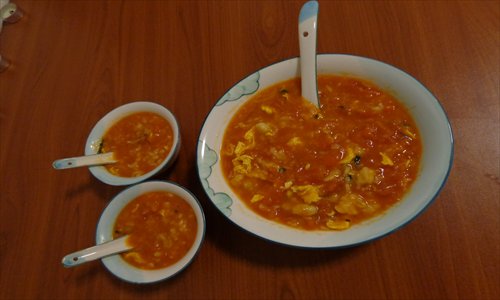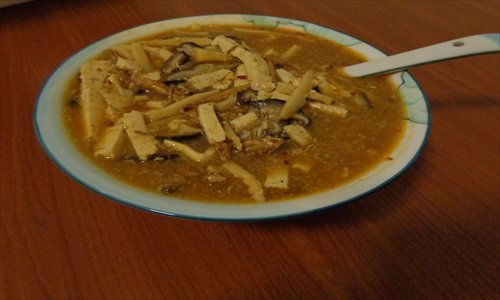Soup's on!


It's time to face it: Winter's here. To some, this means goodbye to good moods and hello to hunkering down for a long winter's scowl. To those who have discovered the joys of cooking to the season, it means a whole array of hearty dishes to choose from, chief among these being soups.
If there is anything I have learned about Chinese cuisine since moving to Beijing, it's that cooks in this country can pull off the most extravagant dishes whose complex flavors could bewilder even the best culinary sleuth, but they're also particularly adept at letting a simple ingredient shine without clustering it with gustatorial adornments. Soups are one of the best examples of this, and no two dishes could better exemplify these extremes than those I've chosen to share below. Each is incredibly quick to create, from beginning to end, so when you just have to have a big bowl of home-cooked soup, keep these recipes on hand for almost instant gratification.
Gedatang
The first time I ordered this dish, I just wanted something simple - no spice, no tangy vinegar, no musky herb rubs, no preserved vegetables. The picture of a plain tomato soup was the only thing on the menu that appealed to me, and I imagined it would be an unexciting, but necessarily bland lunch given my rocky stomach. I was right about its kindness to my tummy, but I was wrong about its profile as a soup not worth mentioning. The tomato flavor was rich, the broth aromatic, and the little dough dumplings hiding beneath the surface were like treasures at the bottom of the sea.
The dish can vary from restaurant to restaurant, and my attempts to pull off the perfect recipe reflected the many ways it can be made, sometimes too thin, sometimes too thick, from bland to overwhelming in umami. For those who prefer not to have to Goldilocks their way to a good, reliable soup, this recipe was a labor of love.
Ingredients:
-½ cup flour
-3 Tbs cold water
-6 medium tomatoes
-3 Tbs peanut or other high-heat oil
-1 egg
-½ Tbs water
-470 milliliters chicken broth
-½ Tbs chopped green onion, green and white parts
-1 Tbs chopped cilantro
-1 tsp soy sauce
-1 tsp salt
-freshly ground pepper
-sesame oil
Instructions:
1. Place flour in a bowl and slowly add cold water while stirring with chopsticks until dough becomes stringy and clumpy. Use as little water as possible to avoid sticky dough. Set away from cooking area to prevent dough from absorbing steam.
2. Peel tomatoes and cut into thin wedges, then in half. Set aside.
3. Beat egg with ? Tbs water, using chopsticks. (The water makes the egg juicy.)
4. Heat an empty wok and turn flame off when quick spray of water from fingertips disappears instantly.
5. Add 1 Tbs oil and roll around sides of wok. Turn flame on high and add egg. Work a spatula through the egg until completely cooked, about 30 seconds. Remove.
6. Add 2 Tbs oil to wok and dump tomatoes in. Cook on high flame about 5 to 7 minutes, stirring all the while, until tomatoes are soft and reduced to a thick, bubbly sauce.
7. Pour in chicken broth, stir well and return to a boil.
8. Stir dough with chopsticks to loosen up, adding a bit of flour if sticky, and drop into boiling soup. Cook about 1 minute, stirring occasionally, while adding soy sauce, salt, pepper, and a drizzle of sesame oil. Return cooked eggs to soup.
9. Toss in green onions and cilantro and stir. Serve immediately.
Suanlatang
While this soup is offered at nearly every Chinese restaurant in the US, where it is known as hot and sour soup, I can honestly say I never had a bowl of it until I moved to Beijing. If anything I'd have a bite and then turn my nose up at it, judging the gelatinous consistency as unappetizing and downright suspicious. The flavor even seemed unnatural and off-putting.
Imagine my surprise when I put faith in my spoon at a typical Beijing restaurant and found a completely different experience. The balance of the hot and the sour was sublime, and the ingredients seemed to complement each other well while managing to remain distinct. It turns out that even the dishes that made it across the ocean have been misrepresented on American soil. I set out to find out how it was made, though I doubt I will ever say the same for the version served in any Chinese restaurant across the pond.
Ingredients:
-150 grams cooked chicken breast, shredded
-1 Tbs rice wine
-1 tsp cornstarch or flour
-1 Tbs soy sauce
-5 or 6 woodear mushrooms, thinly sliced
-150 grams firm tofu, thinly sliced
-100 grams bamboo shoots (I use a package of shoots preserved in red pepper oil), thinly sliced
-940 milliliters chicken broth
-2 Tbs dark vinegar
-1 egg, beaten
-60 milliliters water
-1 tsp cornstarch or flour
-1 tsp chili oil
-1 tsp sesame oil
-freshly ground white pepper
Instructions:
1. Put shredded chicken, rice wine, tsp cornstarch and soy in a bowl and let stand about 5 minutes.
2. Bring broth to a boil in a wok. Add chicken, bamboo and mushrooms, and bring back to a boil. Cook for about 5 minutes on high flame, stirring occasionally.
3. Add tofu and cook about 3 minutes more.
4. Slowly pour beaten egg into boiling soup, stirring gently to spread throughout.
5. Blend water and remaining cornstarch. Pour slowly into the soup and stir to blend. Allow to cook a few minutes to thicken nicely.
6. Add sesame oil, chili oil, and pepper to taste. Serve immediately.